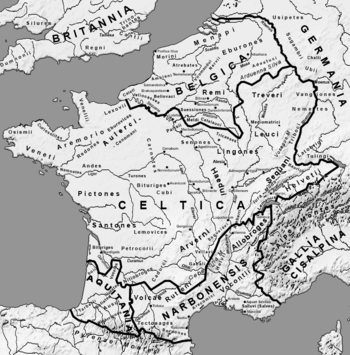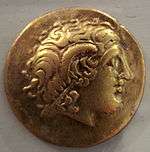Cenomani
- This article is about the Cenomani in Gallia Celtica; for the Cenomani in Cisalpine Gaul, see Cenomani (Cisalpine Gaul).


The Cenomani or Aulerci Cenomani were a Celtic people, a branch of the Aulerci in Gallia Celtica, whose territory corresponded generally to Maine in the modern départment of Sarthe, west of the Carnutes between the Seine and the Loire. Their chief town was Vindinum or Suindinum (corrupted into 'Subdinnum'), afterwards Civitas Cenomanorum (whence Le Mans, and much later the Cenomanian geological age) and later Cenomani as in the Notitia Dignitatum, the original name of the town, as usual in the case of Gallic cities, being replaced by that of the people. According to Caesar (Bell. Gall. vii.75.3), they assisted Vercingetorix in the great rising (52 BC) with a force of 5000 men. Under Augustus they formed a civitas stipendiaria (Roman tributary town) of Gallia Lugdunensis, and in the 4th century part of Gallia Lugdunensis III.
There was another people called Cenomani that held extensive territory in Cisalpine Gaul; however, there is disagreement whether they are one and the same people. The orthography and the quantity of the penultimate vowel of Cenomani have given rise to discussion. According to Arbois de Jubainville, the Cenomni of Italy are not identical with the Cehomni (or Cenomanni) of Gaul. In the case of the latter, the survival of the syllable man in "Le Mans" is due to the stress laid on the vowel; had the vowel been short and unaccented, it would have disappeared. In Italy, Cenomani is the name of a people; in Gaul, merely a surname of the Aulerci. William Smith adopts the difference, placing the peoples in two separate articles in his Dictionary of Greek and Roman Geography. On the other hand, if the tradition recorded by Cato (in Pliny, Nat. Hist. iii. 19. s. 23) is true, that the Cenomani formed a settlement near Massilia (modern Marseille), among the Volcae, this could indicate a route that the Cenomani took to Cisalpine Gaul in Italy. According to Livy, the Cenomani of Cisalpine Gaul arrived after the expedition of Bellovesus, led by Helitovius, and are credited with the foundation of Brixia, or Brescia.
References
 This article incorporates text from a publication now in the public domain: Chisholm, Hugh, ed. (1911). "Cenomani". Encyclopædia Britannica (11th ed.). Cambridge University Press.
This article incorporates text from a publication now in the public domain: Chisholm, Hugh, ed. (1911). "Cenomani". Encyclopædia Britannica (11th ed.). Cambridge University Press. This article incorporates text from a publication now in the public domain: Smith, William, ed. (1854–1857). "Cenomani". Dictionary of Greek and Roman Geography. London: John Murray.
This article incorporates text from a publication now in the public domain: Smith, William, ed. (1854–1857). "Cenomani". Dictionary of Greek and Roman Geography. London: John Murray.
